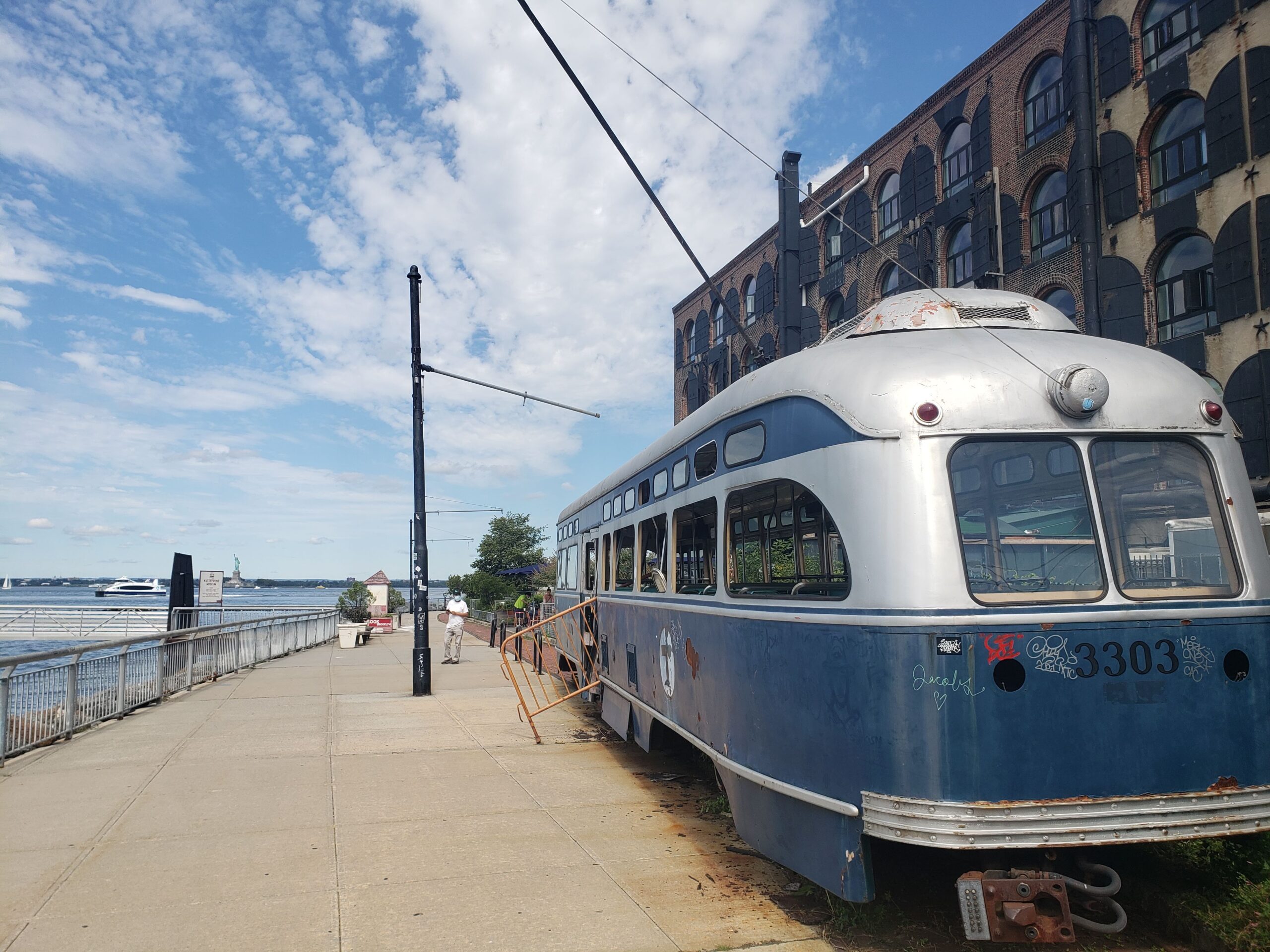Friends of mine visiting New York often ask me to show them around Brooklyn for an afternoon. That brings up a dilemma – Brooklyn is huge, and you couldn’t possibly see it in a few hours. The most populous of New York’s five boroughs, Brooklyn has about 2.5 million people, larger than any city in the US other than New York, LA, and Chicago. While it lacks many of Manhattan’s traditional tourist attractions, Brooklyn’s endless neighborhoods have many charms of their own and are well worth exploring.
The first place in Brooklyn that I generally tell people to visit is the closest part to Manhattan. The neighborhoods of Brooklyn Heights and Dumbo (“Down Under the Manhattan Bridge Overpass”) provide stellar views of the famous island across the water, a glimpse into the Brooklyn waterfront’s industrial history, the beautiful residential blocks of America’s first suburb, and plenty of cafes, restaurants, and bars to soak up the Brooklyn vibe.
Getting There
As the closest part of Brooklyn to Manhattan, Dumbo and Brooklyn Heights are easily accessible by subway. Dumbo is served by the F line at York Street, while Brooklyn Heights is served by the A/C at High Street, the R at Court Street, the 2/3 at Clark Street or Borough Hall, and the 4/5 at Borough Hall.
Another way to get here is by NYC’s public ferry system. Although not always the most convenient, the ferry offers a fun, cheap way to get out on the water and arrive in Brooklyn the way people did two hundred years ago. There are ferry docks in Dumbo and at the southern end of Brooklyn Bridge Park.
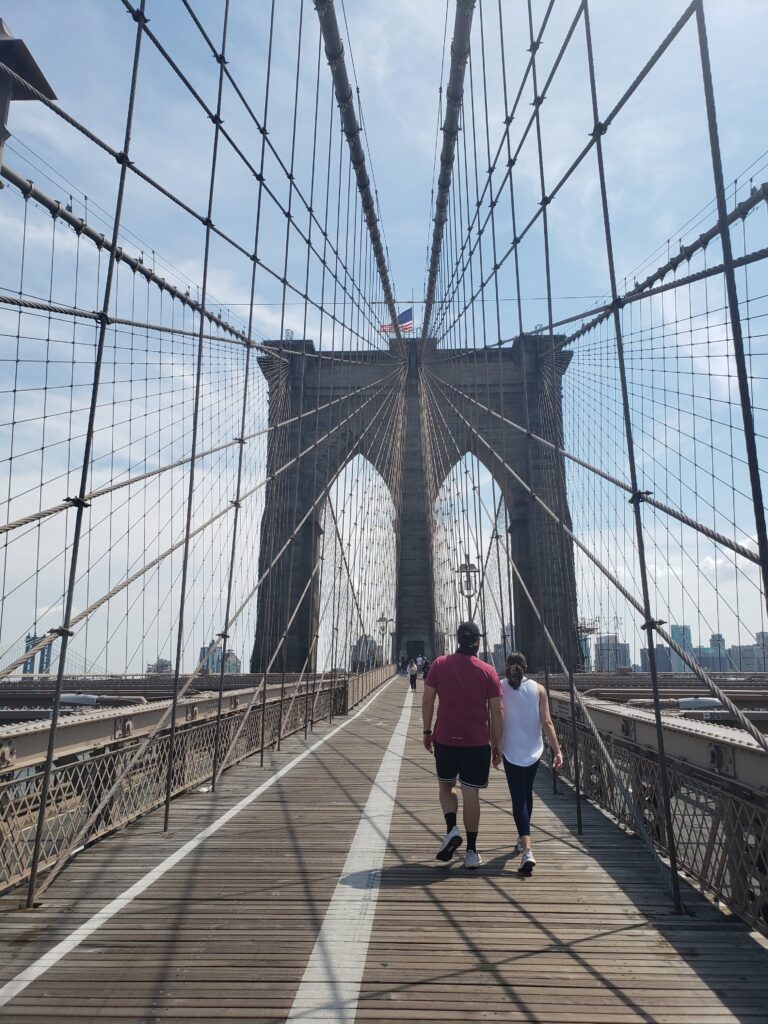
Perhaps the best way to get to this area, though, is by walking or biking across the Brooklyn Bridge from lower Manhattan. The iconic bridge is a marvel of engineering that opened in 1883, spurring Brooklyn’s rapid development. Its massive, Gothic stone towers rise nearly 300 feet, taller than any building in the city but the spire of Trinity Church when it opened. Its suspension cables hold the bridge deck, which originally accommodated streetcars and pedestrians but now carries vehicle traffic.
Both walking and biking across the bridge became significantly more enjoyable in the last two years after the City converted a traffic lane to a new bike path, so pedestrians and bicyclists no longer have to fight over the same narrow space. The bridge will drop you off in Downtown Brooklyn, just a few blocks from Brooklyn Heights and Dumbo.
The Manhattan Bridge also offers bike and pedestrian connections from Manhattan’s Chinatown to Dumbo. Opening in 1909, the Manhattan Bridge was built in a lighter, steel framed style. The bike path (on the north side) and pedestrian path (on the south side) are not quite as pleasant as the Brooklyn Bridge, as they are on the bottom deck adjacent to loud passing subways, but they are far less crowded than the Brooklyn Bridge and offer great views.
What to do in Dumbo
While the name “Dumbo” only dates back to the 1970s (supposedly an attempt by local residents to make the area undesirable for developers), the area is one of the oldest in Brooklyn. Robert Fulton, the inventor of the steamboat, began running a ferry to here from Manhattan in 1814. Dumbo’s cobblestone streets are lined with tall, handsome brick factories and warehouses from the 19th century. The area was a bustling industrial district (its products included the world’s first cardboard boxes!) until the 1950s.
In the 1970s, artists began moving into Dumbo’s vacant warehouses, beginning a long, familiar process of gentrification. A developer gradually bought up the whole neighborhood and convinced the City to rezone it, allowing him to convert the old industrial buildings into new residential and office space. Today, the area’s offices are popular with tech companies, and condominiums sell for millions of dollars.
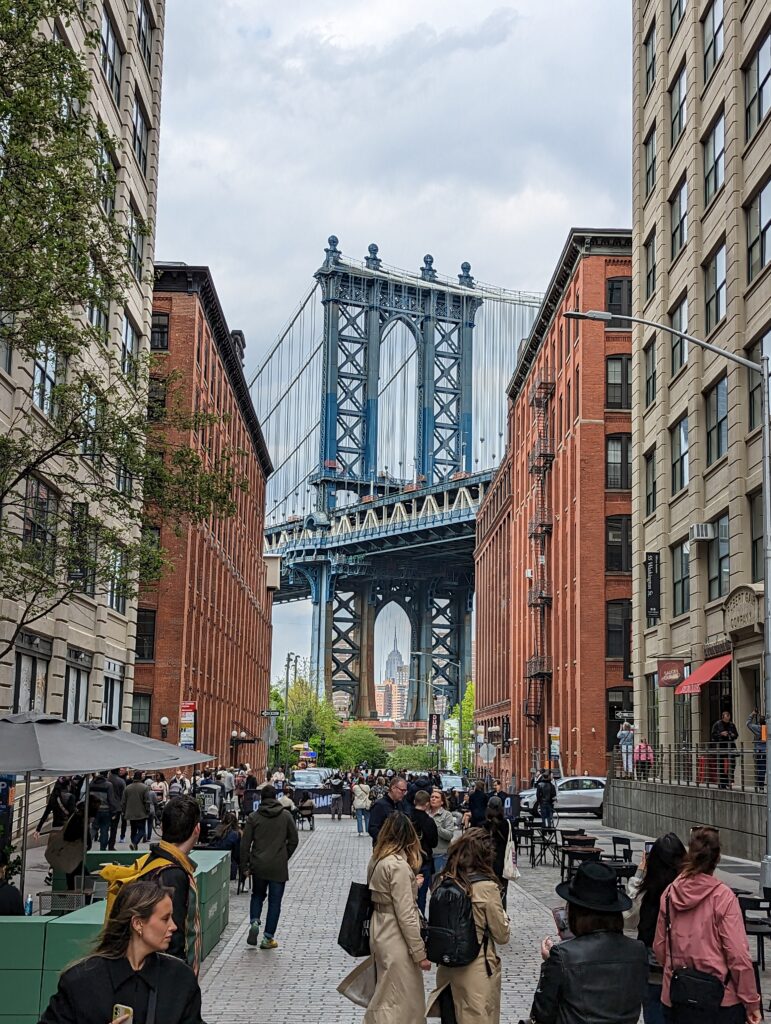
Probably the most quintessential block in Dumbo is Washington Street between Front and Water Streets, often showing up on lists of the most Instagrammable spots in New York. Elegantly restored warehouses on either side of the street frame a perfect view of the Manhattan Bridge, with the Empire State Building centered between its steel towers. The City recently closed off this block to traffic, opening it up for pedestrians to linger, with tables and chairs placed out on the cobblestones on a nice day.
A block to the east is a grand, arched walkway through one of the Manhattan Bridge’s support structures, hosting public art and plentiful seating. On the weekends in the spring, summer, and fall, a flea market takes over the passageway, with vendors selling food, clothing, and all sorts of antique knickknacks.
As you go farther east, Dumbo feels a little bit less gentrified, with more and more industrial uses still surviving. Eventually, you make it to the micro-neighborhood of Vinegar Hill, where a block or two of old rowhouses and a couple hip restaurants sit on another cobblestone street, a sudden respite from the industrial surroundings.
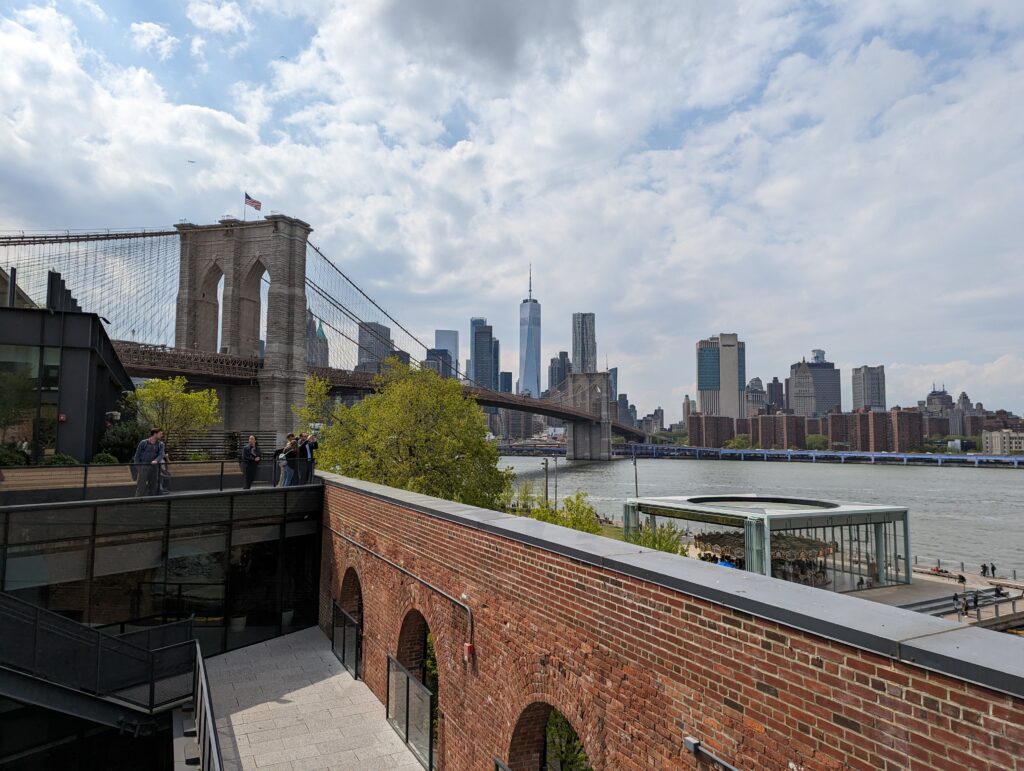
Back to the west, just past the Washington Street view, the streets get busier with locals and tourists. The Empire Stores complex, built in a former coffee warehouse, contains the Time Out Market, a ground-floor food hall with dozens of stands, many of them outposts of long-time New York restaurants. The Market has a second space on the rooftop with a few more eateries and a bar, offering spectacular views of Manhattan and both bridges. The roof is open to the public even if you’re not buying anything, although drinking a beer on its outdoor deck is not a bad idea.
Next door to the Empire Stores, St. Ann’s Warehouse is an arts space in a restored tobacco warehouse, hosting avant garde theater productions throughout the year. Part of the warehouse’s façade was restored but left without a roof, creating a semi-enclosed outdoor garden that is open to the public.
As you pass under the Brooklyn Bridge, you get to the edge of the Dumbo neighborhood, where Fulton’s ferry docked 200 years ago and the NYC Ferry picks up today. On the first block of Old Fulton Street is Grimaldi’s Pizzeria, which has been around for over a hundred years. While it’s not the best pizza I’ve ever had, it provides a true classic New York pizza experience. For a slightly more modern option next door (also by the Grimaldi family), try Juliana’s.
Brooklyn Bridge Park
Although Brooklyn Bridge Park only opened in 2010, today it feels hard to imagine the area without it. Spanning the waterfront from the edge of Dumbo at the Brooklyn Bridge south to Atlantic Avenue, it is composed of a bike and pedestrian path connecting piers that jut out into the water, with a front-row view of the lower Manhattan skyline.
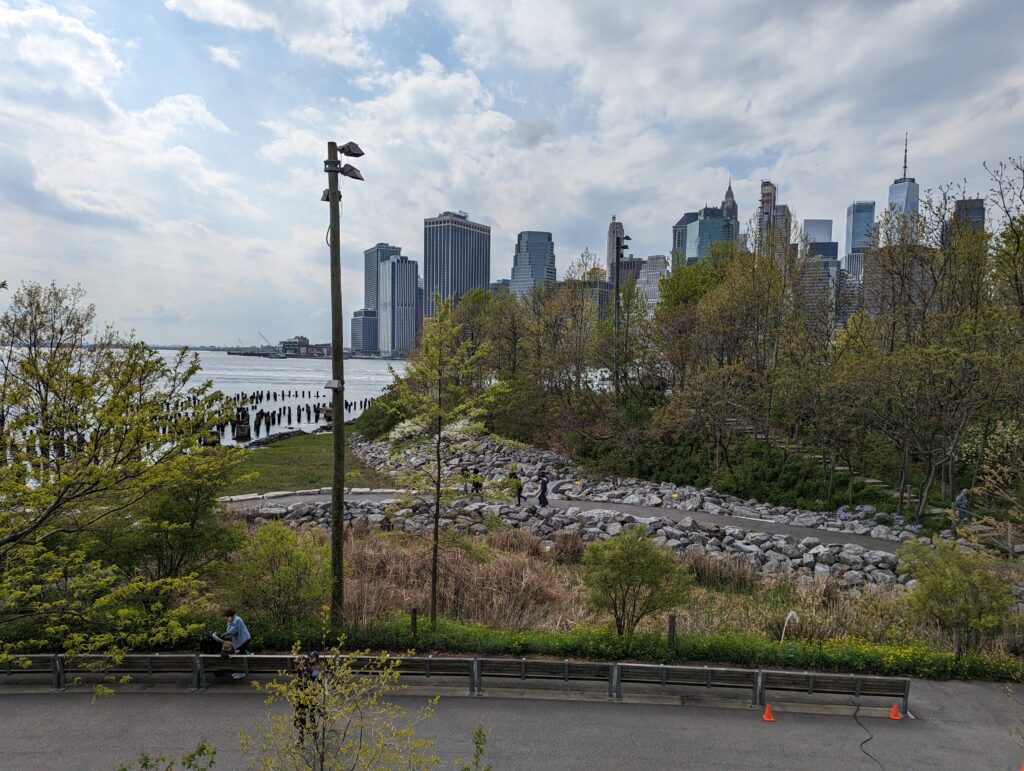
Some piers are lushly landscaped, providing surprisingly quiet natural spaces in the middle of the city, with Manhattan’s skyscrapers peeking through the trees. Others are programmed with sports facilities, including soccer fields and covered basketball courts. At the southernmost pier, near where the NYC Ferry picks up, is one of the city’s most unique dining experiences: an open-air oyster bar on the deck of a century-old wooden boat moored on the water. The restaurant, called Pilot, is (understandably) open only in the summer.
Brooklyn Bridge Park also offers free kayaking in the summer. A few days a week, you can take a kayak out on the East River for twenty minutes at a time, right underneath the skyscrapers of Manhattan. Advanced reservations are required. The bike path through the park continues down to Red Hook, which makes a great add-on to a Brooklyn day trip.
What to Do in Brooklyn Heights
When Robert Fulton started his ferry across the East River, he made commuting from Brooklyn to Manhattan possible for the first time. Wealthy people soon took advantage of this by moving to Brooklyn Heights, just up the hill from the ferry dock, creating America’s first suburb. The beautiful brownstone townhouses they built still line the neighborhood’s narrow, tree-lined streets.
Atlantic Avenue and Old Fulton Street can take you from Brooklyn Bridge Park to Brooklyn Heights, but the more pleasant ways to get up the steep hill are the pedestrian bridge from the northern end of the Park, which snakes between buildings as it gradually takes you up the incline, or quiet, cobblestoned Joralemon Street towards the southern end, which passes under the Brooklyn-Queens Expressway (BQE) into the neighborhood.
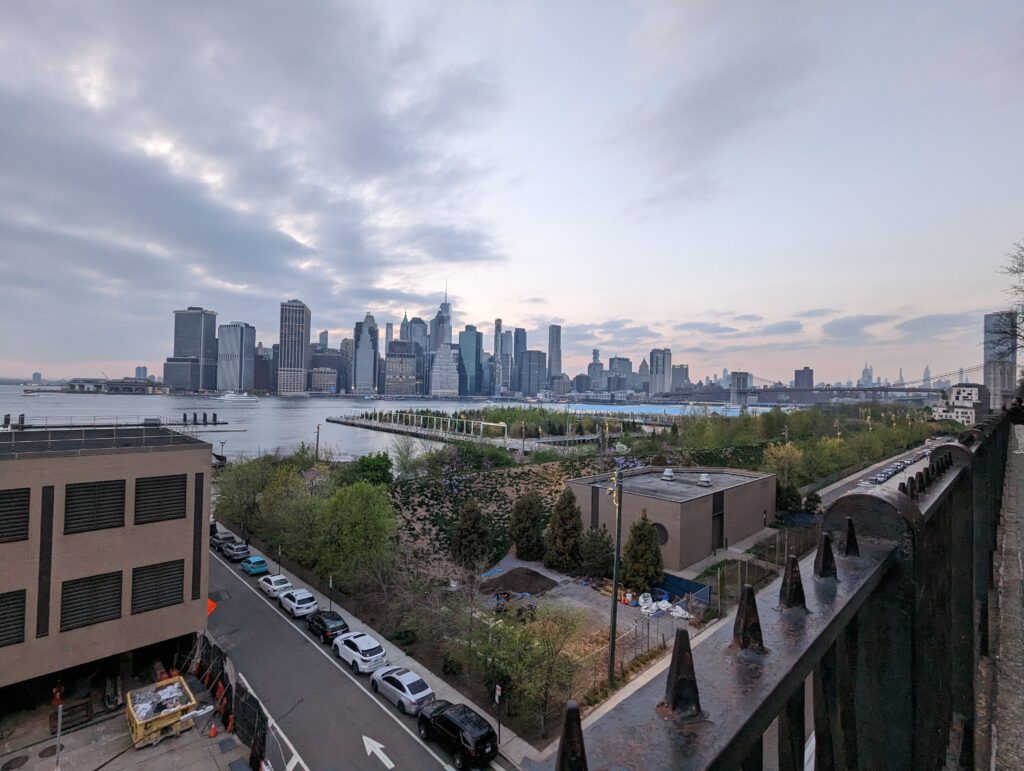
The BQE cuts off Brooklyn Heights from the water, but its impact has been mitigated somewhat by the spectacular Brooklyn Heights Promenade. When the expressway was being planned in the late 1940s and early 1950s, neighborhood residents protested, fearing that the highly trafficked artery would harm their quality of life. Planners compromised by building the expressway in two levels at the base of the hill between Brooklyn Heights and the river, then adding a linear park cantilevered out over the traffic lanes.
When you’re out on the Promenade, you can hardly tell you are standing on top of a freeway that carries hundreds of thousands of vehicles each day. On one side are the backyards of stately rowhouses, and on the other are unobstructed panoramic views. In addition to lower Manhattan right in front of you, you can see out over the harbor to the Statue of Liberty in the south and Midtown’s skyscrapers in the north.
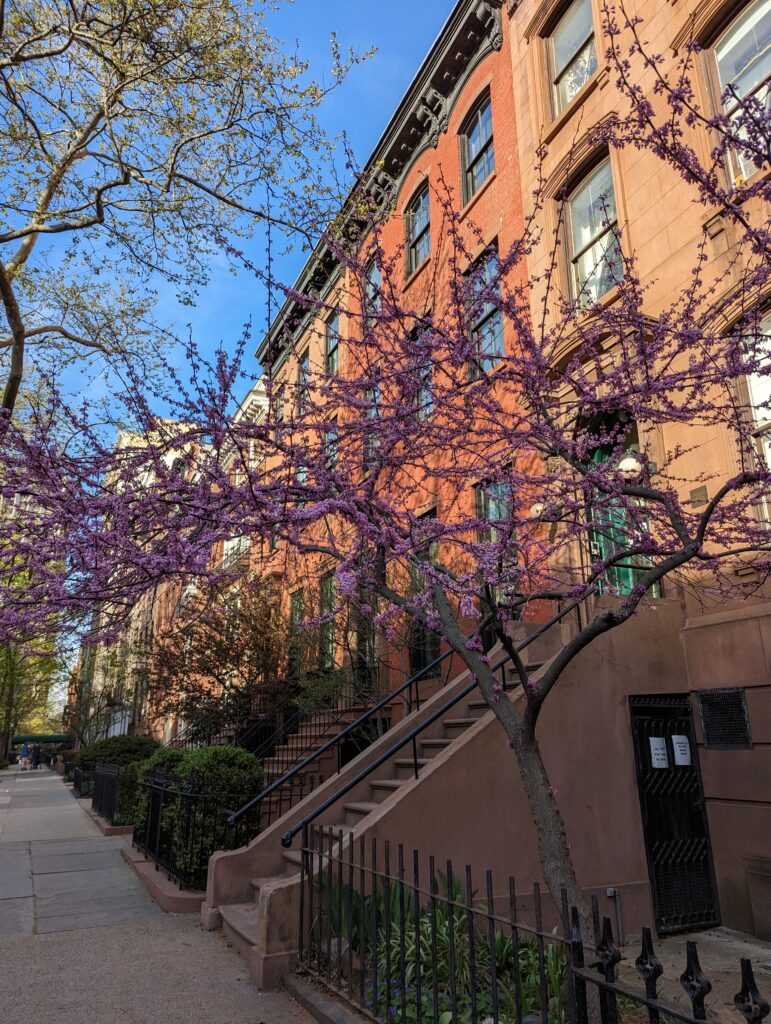
Back into the neighborhood, stroll along the quiet streets, which a number of celebrities now call home. Vineapple Cafe is a great spot for coffee or a light meal, situated on the otherwise residential Pineapple Street, one of a trio of streets curiously named after exotic fruits. Montague Street is the (somewhat sleepy) commercial heart of the neighborhood. Stop by L’Appartement 4F, a French bakery that began as a side project during the pandemic and now sells some of the most talked-about croissants in the city.
The Center for Brooklyn History, at Clinton and Pierrepont Streets, is in a beautiful 19th century building. While it is currently under renovation, it is expected to reopen to the public in fall 2023. Another block east, around the border between Brooklyn Heights and Downtown, is Brooklyn Borough Hall, which was once City Hall before Brooklyn joined New York City as a borough in 1898. Today it serves a mostly ceremonial function.
A couple blocks south at Boerum Place and Schermerhorn Street is the underground New York Transit Museum. Located in an old, disused subway station, the museum collects items from the system’s 120+ year history. Along the station platform are dozens of old subway cars that you can go into, many of them still containing advertisements from when they were last used. On the mezzanine are old turnstiles and other exhibits, as well as a shop with New York transit memorabilia.
Finally, south along Atlantic Avenue is a long-standing Middle Eastern community, with shops and restaurants run by families from Yemen, Lebanon, and elsewhere. One of my favorite restaurants is Al Badawi, a Palestinian restaurant along this stretch of Atlantic, which serves huge platters of chicken, lamb, and rice dishes, with flavors that are nothing like the falafel and shawarma you find at typical American Middle Eastern restaurants.


